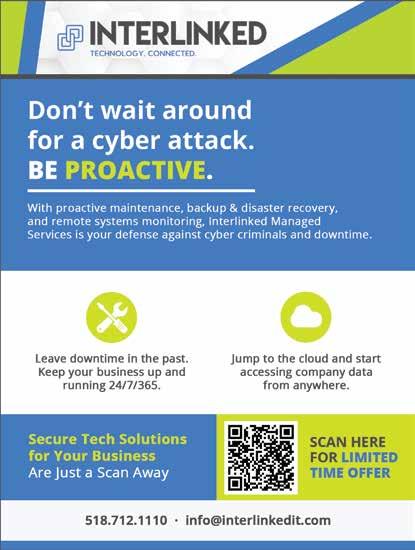
5 minute read
Financial When Your Employees Prosper... So do you!
WRITTEN BY MICHAEL OKBY
When Your Employees Prosper... So do you!
IF YOU ARE AN HR EXECUTIVE, BUSINESS OWNER, OR CEO “ATTRACTING AND RETAINING QUALIFIED EMPLOYEES” HAS LIKELY BEEN TOP-OF-MIND IN 2022.
It has certainly been one of the dominant themes we have repeatedly heard on some level while talking to business leaders throughout the year. It seems that about every industry from hospitality to healthcare has had to deal with these challenges on top of any number of lingering pandemicrelated business issues. Thankfully, it seems the worst of Covid is well behind us now. Many organizations have been able to shift away from “survival mode” back to more routine business matters as existential threats that loomed large over much of the last two years recede. However, the labor pool remains tight so far in the post-Covid environment and is forcing businesses to revisit their recruitment practices in an effort to compete for qualified prospective new hires. At the same time, employees already participating in the workforce are voicing concerns with their employers over a range of issues affecting them and their job satisfaction. Rising inflation, volatility in both stock and bond markets, rising interest rates, and escalating geopolitical conflicts are increasingly weighing on the minds and wallets of America’s workforce. Key takeaways from The Employee Benefit Research Institute’s (EBRI) recent 2022 Workplace Wellness Survey include some alarming statistics that we think employers should be aware of: • 60% of American employees have some concern over their current financial picture - which is up from 49% in 2021. • The 2 primary causes of employee’s financial stress are saving enough for retirement and maintaining enough cash for an emergency. • 80% of employees cite their level of debt as concerning which is up from 65% in 2021. • Over 50% cite healthcare or educational expenses as the biggest driver of their debt.
In a survey done by Morgan Stanley, one company’s Benefits Director was quoted as saying that due to the current environment “People are struggling to make ends-meet and it’s brought us back a little -to worrying less about long term objectives and really helping employees think about managing the more immediate needs.” That has an impact on employees and employers. Studies have shown that when employees bring their financial concerns to work, it negatively affects their productivity and satisfaction with their job. Thankfully, studies also indicate that most employees are currently satisfied, and that their benefits package is the primary driver affecting their satisfaction level. The EBRI survey confirms the above, indicating that Health Insurance and retirement plans continue to be the dominant benefits for employee retention and recruitment. But merely offering a quality benefits package is not enough, as employees need to be regularly informed as to how certain benefits can impact their personal situation. A trend among many organizations ramping efforts to recruit and retain valuable employees has been the adoption of Financial Wellness programs as key components to expanded benefits packages. Today, more than 80% of public companies have adopted Financial Wellness programs that offer solutions to help their employees reduce financial stress and improve their overall wellbeing. It is no longer a question whether top employers should promote financial wellness within their talent pool.
So… What is a Financial Wellness program?
While some may think of Financial Wellness as a suite of offerings to employees, it has been shown that the education component of Financial Wellness is a critical element of a successful program. Employees are busier than ever, so having access to individuals they can call on can be very important. In a 2022 SHRM-Morgan Stanley survey, American workers cited the desirability of Financial Wellness programs as follows, • 51% want Financial Education • 54% want Financial Coaching • 60% want Financial Planning • 45% want Education on Finances Taking a deeper dive into employee talent pools, different generations indicated that Financial Wellness is most desired by the youngest pool of employees and least by the oldest who in many cases have established relationships with Financial Advisors. • Gen Z 65% • Millennials 56% • Gen X 47% • Boomers 41% Historically, health, retirement, and education planning are the most common Financial Wellness benefits offered by employers. With the changing labor force, employees are asking for more. Specifically, they are looking for benefits that allow them to focus their work hours on being productive. You might be surprised to know that many of these benefits are already offered by existing retirement plan record keepers, but employers need to ask. The components of a well-designed Financial Wellness program can include any of the below programs: • A digital platform with access to customized planning services • Emergency savings through payroll programs • Student loan coaching programs • Credit programs • Financial Planning services Regardless of your company, the first step to implementing an effective Financial Wellness program should be to spend some time on the design and development of a curriculum that helps meets your specific employee population’s needs. Once you have gone through that process, this is your opportunity to communicate directly with your employee base to launch the program. Finally, on an ongoing basis it is critical that you measure the success of the program and establish a way for employees to provide feedback and insight. The goal of your financial wellness program should be to help employees move from a state of financial stress to a state of financial confidence. In doing so, you’ll potentially provide a boost to workplace morale, improve your recruitment efforts, and increase retention of valued employees.
H. Michael Okby is a Senior Vice President and Wealth Advisor with the Wealth Management division of Morgan Stanley in Saratoga Springs, NY.
The views expressed herein are those of the author and may not necessarily reflect the views of Morgan Stanley Smith Barney LLC, Member SIPC. H. Michael Okby may only transact business in states where he is registered or excluded or exempted from registration www.morganstanleyfa.com/ theokbygroup website or FINRA Broker Check site http://brokercheck.finra. org/Search/Search.aspx. Transacting business, follow-up and individualized responses involving either effecting or attempting to effect transactions in securities, or the rendering of personalized investment advice for compensation, will not be made to persons in states where H. Michael Okby is not registered or excluded or exempt from registration. The strategies and/or investments referenced may not be appropriate for all investors. Information contained herein has been obtained from sources considered to be reliable, but we do not guarantee their accuracy or completeness. Morgan Stanley and its Financial Advisors do not provide tax advice. Individuals are urged to consult their tax advisor regarding their own tax or financial situation before implementing any strategies. CRC 5181463 11/2022











